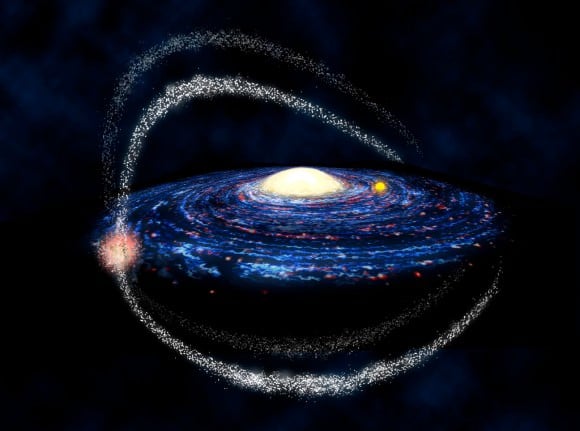[/caption]
Galactic interactions can have big effects on the shapes of the disks of galaxies. So what happens when a small galaxy intermingles with the outer part of our own larger Milky Way Galaxy? It's not pretty, as rivers of stars are being sheared off from a neighboring dwarf galaxy, Sagittarius, according to research by a team of astronomers led by Sergey Koposov and Vasily Belokurov (University of Cambridge).
Analyzing data from the latest Sloan Digital Sky Survey (SDSS-III), the team found two streams of stars in the Southern Galactic hemisphere that were torn off Sagittarius dwarf galaxy. This new discovery also connects newly found streams with two previously discovered streams in the Northern Galactic hemisphere.
Describing the phenomenon, Koposov said, "We have long known that when small dwarf galaxies fall into bigger galaxies, elongated streams, or tails, of stars are pulled out of the dwarf by the enormous tidal field."
Wyn Evans, one of the other team members commented, "Sagittarius is like a beast with four tails."
At one time, the Sagittarius dwarf galaxy was one of the brightest of our Galaxy's satellites. Now its remains are on the other side of our Galaxy, and in the process of being broken apart by immense tidal forces. Estimates show that the Sagittarius dwarf galaxy lost half its stars and gas over the past billion years.
Before the SDSS-III data analysis, it was known that Sagittarius had two tails - one in front of and one behind the remnant. This discovery was made by using previous SDSS imaging, specifically a 2006 study which found the Sagittarius tidal tail in the Northern Galactic sky appears to be split in two.
Commenting on the previous discovery, Belokurov added, "That was an amazing discovery, but the remaining piece of the puzzle, the structure in the South, was missing until now."
Analyzing density maps of over 13 million stars in the SDSS-III data, Koposov and his team found that the Sagittarius stream in the South is also split into two. One stream is thicker and brighter, while the other is thinner and fainter. According to the paper, the fainter stream is simpler and more metal-poor, while the brighter stream is more complex and metal-rich.
The deduction makes sense since each successive generation of stars will create and distribute (via supernovae) more metals into the next generation of star formation.
[caption id="attachment_91530" align="aligncenter" width="580" caption="An artist's impression of the four tails of the Sagittarius Dwarf Galaxy (the orange clump on the left of the image) orbiting the Milky Way. The bright yellow circle to the right of the galaxy's center is our Sun (not to scale). Image credit: Amanda Smith (University of Cambridge)"]
[/caption] While the exact cause of the tidal tail split is unknown, astronomers believe that the Sagittarius dwarf may have been part of a binary galactic system, much like the Large and Small Magellanic Clouds, visible in our Southern hemisphere. Despite the nature of the tidal tail split being presently unknown, astronomers have known that over time, many smaller galaxies have been torn apart or absorbed by our Milky Way Galaxy, as well as other galaxies in the Universe.
The movie (below) shows multiple streams produced by the disruption of the Sagittarius dwarf galaxy in the Milky Way halo. Our Sun is depicted by the orange sphere. The Sagittarius dwarf galaxy is in the middle of the stream. The area shown in the movie is roughly 200,000 parsecs (about 600,000 light-years.) Movie credit: S. Koposov and the SDSS-III collaboration.
If you'd like to learn more, you can read the full scientific paper at:
arxiv.org
Source:
SDSS press release
,
arXiv paper #1111.7042
 Universe Today
Universe Today

